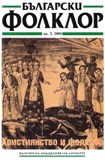Фолклор и православно християнство (По наблюдения върху културното пространство на рилския манастир)
Folklore and Orthodox Christianity (On the Basis of Observations on the Cultural Space of the Rila Monastery)
Author(s): Rossen MalchevSubject(s): Anthropology
Published by: Институт за етнология и фолклористика с Етнографски музей при БАН
Summary/Abstract: This research expands the knowledge of the mechanisms for creation and existence of the local versions of folk confessionality (religiosity) in West-Bulgarian lands. The attention is focused on the northern parts of the Rila monastery cultural space (the regions of Vratza, Montana, Chiprovtzi, Berkovitza, Sofia and Samokov). At first, during the period from the 10th to the end of the 14th century, the interaction between religion and folklore in the folk faith and the concrete cultural practice of local communities leads to the creation and development of phenomena, which are dominated by Orthodox Christianity. Most typical are the cults of saints and sanctuaries, which follow the model of the cult of St. Ivan of Rila in the Rila monastery. After the end of the 14th century, when the regions in question are inhabited by Muslim population, the development of folk confessionality (religiosity) goes into a new direction. The preservation of cleric and local Orthodox communities, which is characteristic for the western parts of Bulgaria, assures the further evolution of local folk cults of the Christian hypostases of St. Ivan of Rila. At the same time, the religious and socio-cultural interaction between Orthodox and Muslim communities results in the creation of bi-religious Christian-Muslim phenomena and their Muslim ingredient is a constituent of the local folk Muslim confessionality (religiosity). The research reveals that these phenomena are formed and function under the strong influence of the cult of St. Ivan of Rila and its sacred centers, as well as the corresponding concepts, beliefs, story types, song motifs, toponyms, idioms, etc.
Journal: Български фолклор
- Issue Year: XXVI/2000
- Issue No: 3
- Page Range: 52-62
- Page Count: 11
- Language: Bulgarian
- Content File-PDF

